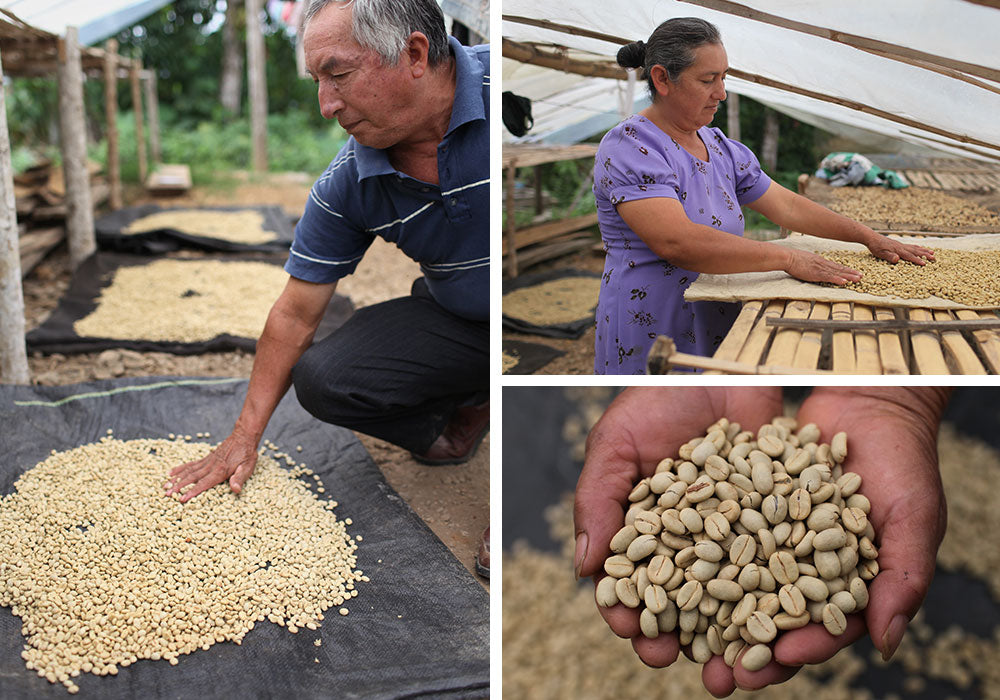We like to understand every step of the way with the coffee you drink every morning. Learning what seed to cup means gives us an appreciation for the coffee journey. When we partnered with the Primero de Mayo community in Peru we tracked the annual process.
GENERAL PREP WORK
January 2018
Currently on the coffee farm, the farmers are continuing to prep for the coffee growing season. Planting occurred a few months ago, and now farmers are continuing to monitor the fields to ensure pest and disease problems can be prevented, ensuring a bountiful crop for harvesting.
THINNING PRACTICE
February 2018
Our coffee farmers in Peru are now thinning the fruit on the growing coffee plants, to allow for more shade on each individual plant. This will help to improve not only the quality of the Arabica coffee bean itself, but also guarantee a higher quality cup of coffee as an end result.
PEST & DISEASE CONTROL
February 2018
Currently on the coffee farm, the farmers are continuing to prep for the coffee growing season. Planting occurred a few months ago, and now farmers are continuing to monitor the fields to ensure pest and disease problems can be prevented, ensuring a bountiful crop for harvesting.
HARVEST
May 2018
Primero de Mayo is not only the name of our partner community in Peru, but the start of the coffee harvesting season! The coffee crop is picked by hand. Over the next few weeks, the pickers will select only the ripe coffee cherries off each plant, signified by the deep, dark red color of the fruit.
PROCESSING
June 2018
Once the coffee has been picked, processing must begin as quickly as possible to prevent fruit spoilage. Depending on location and local resources, coffee is processed in one of two ways: dry or wet processing.
The Dry Method is the age-old method of processing coffee and is still used in many countries where water resources are limited. The freshly picked cherries are simply spread out on huge surfaces to dry in the sun. In order to prevent the cherries from spoiling, they are raked and turned throughout the day, then covered at night or during rain to prevent them from getting wet. Depending on the weather, this process might continue for several weeks for each batch of coffee until the moisture content of the cherries drops to 11%.
The Wet Method removes the pulp from the coffee cherry after harvesting so the bean is dried with only the parchment skin left on. First, the freshly harvested cherries are passed through a pulping machine to separate the skin and pulp from the bean.
Then the beans are separated by weight as they pass through water channels. The lighter beans float to the top, while the heavier ripe beans sink to the bottom. They are passed through a series of rotating drums which separate them by size.
After separation, the beans are transported to large, water-filled fermentation tanks. Depending on a combination of factors -- such as the condition of the beans, the climate and the altitude -- they will remain in these tanks for anywhere from 12 to 48 hours to remove the slick layer of mucilage (called the parenchyma) that is still attached to the parchment. While resting in the tanks, naturally occurring enzymes will cause this layer to dissolve.

DRYING
July 2018
When fermentation is complete, the beans feel rough to the touch. The beans are rinsed by going through additional water channels and are ready for drying.
These beans can be sun-dried by spreading them on drying tables or floors, where they are turned regularly, or they can be machine-dried in large tumblers. The dried beans are known as parchment coffee and are warehoused in jute or sisal bags until they are readied for export.

HARVEST SEASON > LUNA COFFEES
Sept 2018
Harvest season is coming to a close and the new coffee crop will find its way to our roastery back in Denver, Colorado. Each one of our brands utilizes the Peruvian coffee farmed in Primero de Mayo - from our bright and delicious Boyer's Organic and Mashup Coffees to the Pure Peruvian coffee found in our Boca Java lineup. Don't forget! Proceeds from every bag sold in stores or online go directly back to the schoolhouse building project - we couldn't have made this happen without our amazing customers' support!


